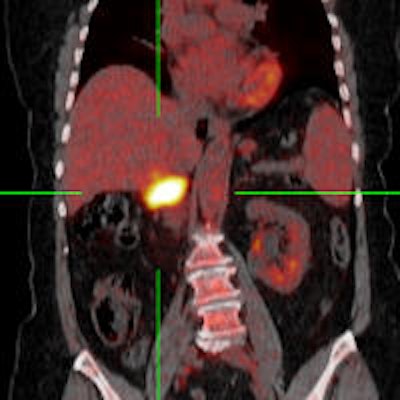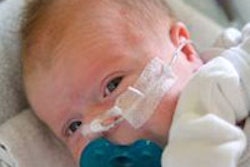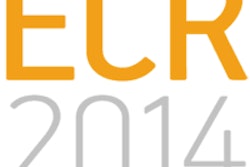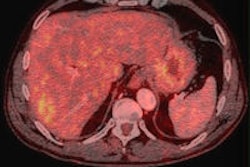
The U.K. Royal College of Radiologists (RCR) has published updated recommendations for the use of pediatric PET/CT. The 16-page document can be downloaded free of charge from the RCR's website.
The second edition -- Ref No: BFCR(14)3 -- takes over from the first edition, published in 2008. The report was updated by Dr. Rosemary Allan, a consultant radiologist at St. George's Healthcare National Health Service (NHS) Trust in London and Dr. Lorenzo Biassoni, a consultant pediatric nuclear medicine physician at Great Ormond Street Hospital for Children, also in London, with help from the Intercollegiate Standing Committee on Nuclear Medicine and the RCR's Radionuclide Radiology Subcommittee.
"In the face of limited published data and experience, this report was compiled by individuals with experience in scanning children with PET/CT in the U.K. and pediatricians involved in clinical management of the type of conditions for which PET/CT is likely to be used. It represents a consensus reached between the authors of what is desirable 'best' practice," they noted.
The use of PET/CT in adult oncology, neurology, and cardiology is well established, but experience with PET/CT in the field of pediatric imaging is limited, particularly when it comes to F-18 FDG, the common tracer used in clinical PET/CT.
Issues specifically relating to children are discussed in this document. Interestingly, the authors clearly state that no pediatric tumor has been identified as non-FDG-avid, thus broadening the potential role of FDG-PET/CT to be applicable in any pediatric oncologic condition, in principle at least. Also, the inherent limited evidence in rare conditions precludes the application of evidence-based criteria as postulated for adult PET/CT imaging.
Being a companion document to "Evidence Based Indications for PET-CT in the United Kingdom," the authors state that only "in rare conditions, the routine use of PET/CT cannot be recommended, but PET/CT may be able to assist in individual management by resolving clinical questions that are difficult to answer using anatomical imaging alone."
This seems a particularly "PET-prone" statement from an interdisciplinary expert group, which is basically touting PET/CT for pediatric oncology and certain indications in pediatric cardiology and neurology, although it is accompanied by the proper recommendations to reduce radiation exposure in children. Such analysis may lead to a redefining of the role of nuclear medicine in children.
Radiation protection issues are extensively covered in the report, reflecting international and national standards. As a further reference here, the appropriate nuclear medicine radiation dose tool on the newly relaunched Society of Nuclear Medicine and Molecular Imaging (SNMMI) homepage is of relevance. Click here to read more.
Also of significance is the recommendation to consider using PET/MRI "where applicable" in favor of PET/CT; the CT part of the examination accounts for a considerable amount of total dose, especially in repeat follow-up scans. A drawback, however, is the very limited clinical access to PET/MRI scanners, particularly in the U.K.
The authors urge everybody to consider these key points:
Scan children with conditions when there is good evidence for the use of PET/CT in adults. In other conditions, the use of PET/CT must be assessed on a case-by-case basis.
Liaison with patients/carers in advance of the scan is required.
Any examination requiring anesthesia or sedation should be carried out in centers with personnel and equipment immediately available to manage pediatric emergencies.
Neurology and cardiology examinations for children requiring monitoring need to be carried out in centers with pediatric services.
Examinations where a CT scan is performed with intravenous contrast at the same scanning session as the PET/CT scan should be carried out in centers with pediatric services.
Patients under the age of 13 should be scanned in specialist regional PET/CT units with experience in scanning children. Ideally, these units should have direct access to pediatric inpatient services. Older children with development problems and children with severe systemic illness will also need to be scanned in specialist units.
Children between the ages of 8 and 12 could be scanned in sites without pediatric services, but at the discretion of the referring pediatrician, provided an individual trained in advanced pediatric life support is in the vicinity and a pediatric resuscitation kit is available.
Studies should be performed by staff who scan children on a regular basis with experience in pediatric cannulation.
Scans should be interpreted by nuclear physicians or radiologists who regularly report the type of pediatric study being performed.
Regular audit and review of scan procedure, quality, and interpretation is mandatory, and PET/CT protocols should be optimized in accordance with the ALARA (as low as reasonably achievable) principle.
Scans should be performed at sites more local to the patient in circumstances laid down but according to protocols developed at the regional center with reporting carried out at the regional center.
"Given the complexity of requirements for PET/CT scanning in children, and the need to develop and maintain expertise in the reporting of sometimes rare conditions in children, specialist regional centers should be established in the U.K.," concluded the authors.



















